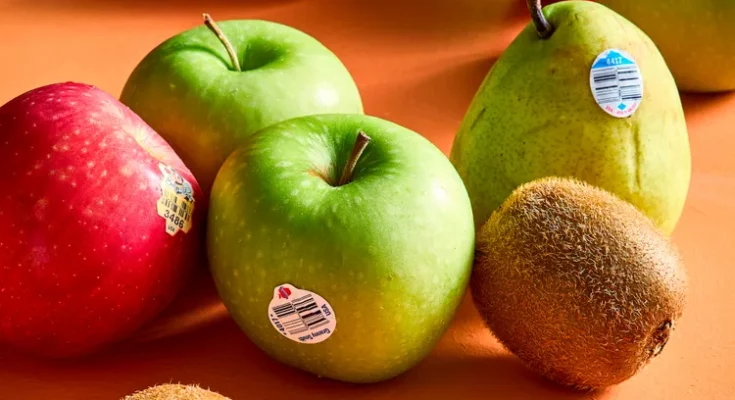And what’s it there for, anyway? A registered dietitian weighs in.
When stocking up on apples, bananas, and avocados at the grocery store, you’ve likely noticed that many fruits and vegetables come with a sticker on their surface. These stickers are also known as PLU (price look-up) labels, as they feature a four- or five-digit code that helps cashiers identify each item and its price. PLU stickers are helpful for consumers, too, as they can tell you the type of produce (such as an apple), the variety (such as Honeycrisp) and the growing method (such as organic or conventional).
If you’ve ever bitten into an apple and realized you forgot to remove the sticker first, you might have wondered whether or not those stickers are edible. To find out, we asked Stephanie Crabtree, M.S., R.D.
Can You Eat the Sticker on Produce?
If you’ve ever eaten a produce sticker by mistake, there’s no need for alarm: Crabtree says that accidentally eating a produce sticker is unlikely to cause any harm. “The materials used are regulated by the FDA and considered food-safe, meaning they are non-toxic if consumed,” she says.
That said, don’t make a habit of it. Fruit stickers are not designed to be eaten—they have no nutritional value and they are not digestible, meaning they won’t break down in your body. “While the materials used are generally recognized as safe, there’s limited research on the long-term effects of consuming them,” Crabtree says. “Rule of thumb: remove the sticker, wash your produce thoroughly, and if you accidentally consume it, don’t worry about it.”
Why Do Fruits and Vegetables Have Stickers?
Produce stickers are a way to display PLU codes, which have been used in grocery stores to help identify and price bulk produce accurately since 1990. The International Federation for Produce Standards, a global organization that assigns PLU codes, manages a database of over 1,500 unique codes, from Honeycrisp apples (3283) to rhubarb (4745) to beefsteak tomatoes (3061).
You can tell a lot about a piece of fruit from its PLU code. According to the IFPS, PLU codes identify different types of produce by attributes including the commodity, variety, growing methodology (organic or conventional), and size. The codes themselves are either 4 or 5 digits: 4-digit codes are used for conventionally grown produce and 5-digit codes starting with 9 are used to identify organic produce. A conventionally grown red bell pepper has a PLU of 4688, for instance, while an organic red bell pepper has a PLU of 94688. Produce stickers sometimes include other information as well, such as the growing location.
What Are Produce Stickers Made Of?
According to Crabtree, fruit stickers are usually made of three components: a label made of paper or plastic, a food-grade adhesive, and a food-safe ink. But just because these materials are food-safe doesn’t mean they’re meant to be eaten. “While these materials are non-toxic, the sticker is not digestible,” she says. “If swallowed, it will likely pass through the digestive system.”
Produce stickers are required to be made of food-grade materials, as defined by the FDA, so they must be safe for incidental food contact or meet standards for indirect consumption. “The adhesives are considered food-safe under FDA regulations, which means they’re permitted to come into contact with food,” Crabtree says. “That said, they are not intended for consumption. Accidental ingestion is not dangerous; however, it is best to remove the sticker before eating.”
Food stickers aren’t required to list their ingredients, and Crabtree notes that there is a small chance that someone with a specific chemical or adhesive sensitivity could have a reaction. These cases would be extremely rare, she says, but she still recommends removing the sticker and washing produce before eating as a precaution.



